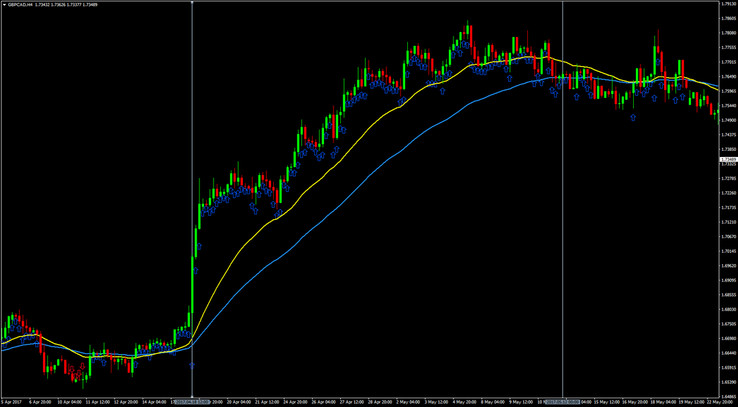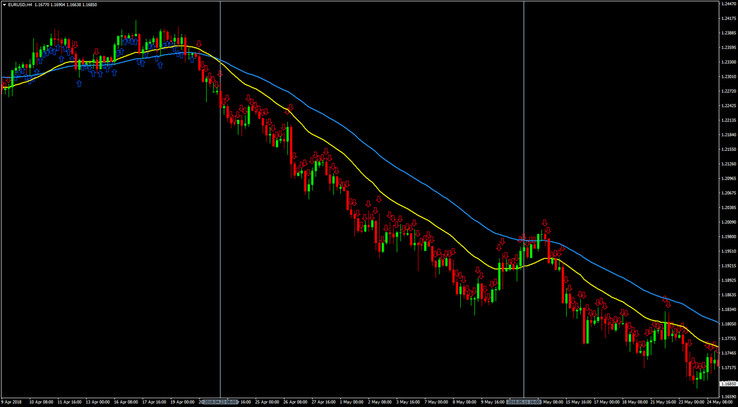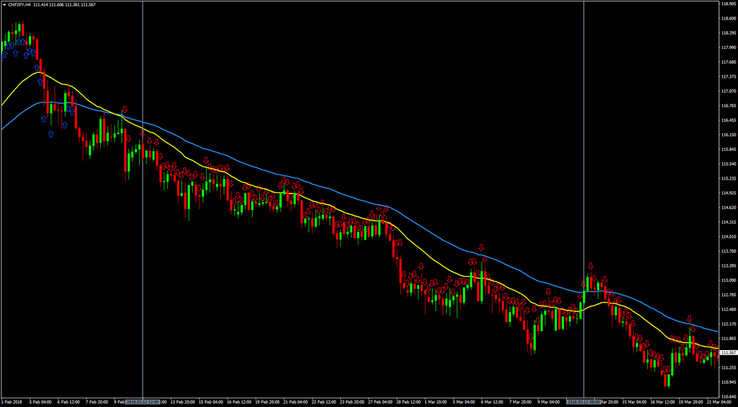This is a powerful trading strategy that works very well during strong market trends and can offer excellent rewards.
Most importantly, due to the accuracy of the indicators used and the conditions under which they are used, this strategy enables traders to enter only the best and strongest Forex trends out of which the best trading opportunities are filtered out and considered for taking a trade. It may not generate as many trades as other strategies, but trades which are generated are with a higher degree of accuracy.
It’s easy to implement and to use this strategy. It doesn’t require expert knowledge of the markets or extensive understanding of technical analysis principles. The strategy can be applied on all currency pairs with pretty much the same performance/results. It also works well on different timeframes, but the 4-hour chart has shown the most profitable results.
On the chart below, we show a real Forex example of how this strategy based on the FxTR Improved RSI indicator and two EMAs looks on the charts:
The entry is at the vertical line on the left, while the exit is at the vertical line on the right (yellow MA starts to slope upwards) - A short trade example that resulted in a profit of over 300 pips on the CHFJPY 4h chart
Indicators to be used:
Three indicators are needed to trade this strategy:
- 30 period exponential moving average (yellow on the charts)
- 60 period exponential moving average (blue on the charts)
- The FxTR improved RSI indicator - Created by the Fx Trading Revolution Team, this RSI-based indicator is very effective in predicting longer-term trends
Trading conditions and rules of the strategy:
Long trade entry :
- Wait for the 30 period moving average (yellow) to cross above the 60 period moving average (blue)
Long trade stop loss :
- Place stop below the 60 period moving average (blue)
- Trail the stop behind the 60 period moving average as the market ascends higher
Long trade exit :
- Hold trade for as long as the RSI shows a blue (bullish) signal
- Close the trade if the yellow moving average starts to slope down
- Or if the RSI turns bearish (red)

A long trade generated on the GBPCAD 4-hour chart - The entry signal is shown with the vertical line on the left and the exit signal is shown with the vertical line on the right
Short trade entry :
- Wait for the 30 period moving average (yellow) to cross below the 60 period moving average (blue)
- Ensure that two moving averages are sloping down
- The 30 period moving average (yellow) is sloped down at an angle of 20 degrees or steeper – No exact measurement is necessary here, but a subjective estimate is good enough
- Look for a red arrow to appear on the RSI indicator after the 3 criterions for the moving averages are satisfied
- Once all of the above conditions are fulfilled, a short trade can be taken
Short trade stop loss ::
- Place stop above the 60 period moving average (blue)
- Trail the stop behind the 60 period moving average as the market descends lower
Short trade exit :
- Hold trade for as long as the RSI shows a red (bearish) signal
- Close the trade if the yellow moving average starts to slope upward
- Or if the RSI turns bullish (blue

The sell signal is shown with the vertical line on the left and the exit signal is shown with the vertical line on the right - EURUSD 4-hour chart
Core principles to remember for this Forex trading strategy:
- Trading signals from the RSI should be ignored if the conditions of the moving averages are not satisfied first. That is, for a bullish signal of the RSI to be valid the 30 period (yellow) MA should be above the 60 period (blue). For a sell signal from the RSI to be valid, the 30 period should be below the 60 period moving average. This significantly helps to filter out noise moves in the market and reduce whipsaw signals that will result in bad trades. Thus, the overall performance of the strategy and the final results are improved by a marked level just by using this specific combination of the indicators.
- It is recommended to lock in some profits from time to time. It’s not always necessary to wait for an exit signal from the indicators to close a part of the position. Since this is a trend trading strategy, the exit signal generated by the RSI and moving averages will tend to eat into the profits to some degree. Using some leading indicators like Fibonacci retracements or support and resistance zones from higher (like the daily or weekly charts) can help you to lock in partial profits at key technical levels just in case if the market suddenly reverses. In this way, the trader still gets to keep some of the profits in such cases.
- This strategy doesn’t use profit targets because it tries to capitalize on trends which can last for an undetermined time and distance on the charts. Hence, for a trending market environment, it’s usually better to just trail the stop behind the price instead of using fixed profit targets. Very often the profit targets are exceeded in trending markets so constantly using them can actually reduce the profits for the trader in the end.





